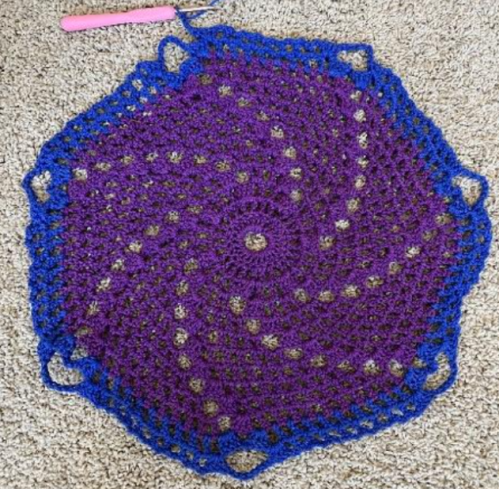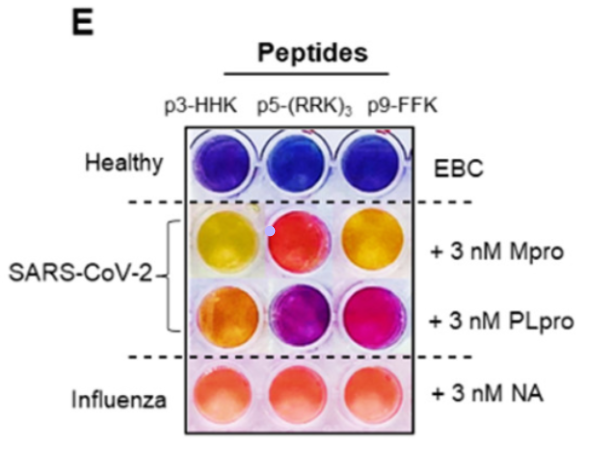What do silver nanoparticles have to do with snowflakes and crochet? Usually, not much! But recently, scientists have created methods to make snowflake-like shapes out of silver nanoparticles 1, and their methods reminded me not only of snowflakes but also of how I make some of my own crochet projects.

So what do these different shapes have in common? Snowflakes, like many other structures in the natural world, are composed of patterns called fractals. Fractals are complex shapes that have self-repeating units, meaning that no matter how zoomed out or in you are, the shape will appear consistent.
Take, for example, a bare tree. Zoomed out, you see a maze of different branches coming off a main trunk to make up the whole tree. Zoom in on one branch, and it starts to look like a trunk with smaller branches shooting off from it. And zoom in further, and the smaller branches have even more twigs branching out from them. Each time you zoom in, the image consists of a similar repeat unit. Although eventually a tree branch will end in a leaf bud or flower, in a mathematical fractal, you can keep zooming in infinitely.

Fractal patterns come into play with snowflakes as well! In snowflakes, the ice crystals form as layers of water molecules that will stick to the frozen surfaces of the flake, with the corners building up faster than the edges up into a beautiful six-sided pattern (see “The Science of Snow” for lots more detail!). This creates a natural fractal as well, with the arms having further branching regions that create a sense of self-similarity regardless of how zoomed in you are on the snowflake.

But what about crochet? As an avid fiber artist, I was also glad to learn that fractals make for easy patterns to crochet. This helped me to really visualize how the zoom-in and zoom-out of fractals works by simply relating it to a partially done project. Take this doily that I created to understand fractals a bit better. :

In the early stages of creating the design, it forms a distinct spiral pattern.

As I built it further out, the same overall shape remained. No matter how far along the pattern was, it still looked very similar, just at a different size.

This is one of the key characteristics to a fractal pattern: it is self-similar at different magnifications.

In the natural world, as well as in crochet, there are limits to how small or how large the object is before it stops repeating. Take, for example, a crocheted snowflake. In the pattern I made, there are twelve arms that extend from the center in an alternating long-short arm fashion, and on each of those arms, there are further branching knobs (called “picots” in crochet terms). However, further branches are virtually impossible to add to the design (at least, while using the same yarn) due to the limits of how small a single stitch is.

This is true of all natural fractals: tree branches eventually end, snowflakes can’t keep accumulating ice beyond a small diameter, and a crochet branch cannot get smaller than a single stitch. But in theory, fractals can repeat an infinite number of times. Take, for example, a geometric shape called the Koch snowflake:

In this design, each iteration adds a new equilateral triangle on the external side of a previous triangle. As it builds out, the structure takes on a snowflake-like form. Zooming in on any external side, no matter how zoomed in, would give the same image of a triangle with smaller and smaller triangles attached to it, repeating down to an infinitely small triangle.

Now, back to nanotechnology. Recently, there has been a lot of investigation into ways to apply fractal designs to different technologies. After all, the predictability of the structure and the large surface area can create highly desirable properties that have already been exploited in natural organisms like trees and plants. We’ve talked a lot on this blog about how increased surface area is a super important aspect of nanotechnology, and you can see that the surface area on the right is much greater than on the left:

In one example of using fractals in nanoscience, scientists have been able to design a snowflake-like fractal made from silver nanoparticles. They used peptides to bridge the silver nanoparticles, causing them to aggregate into the hyperbranched fractal structures.

Preliminary studies have found that these silver nanoparticle fractals can be used as a colorimetric sensor for differentiating viruses. Briefly, what this means is that when virus proteins are added to the bridging peptides and silver nanoparticles, the virus proteins can interfere with the building of the silver fractals. This can all be visualized with the naked eye, where the fractal solutions are a deep blue and the solutions with virus interference are more red and yellow. Even more impressively, the researchers who did the study were able to differentiate (with 100% accuracy!) between samples spiked with coronavirus and samples spiked with influenza entirely by this fractal-interference difference in color.

As scientists continue to discover new ways to create nanoscale fractals, we can continue to take advantage of their unique properties. Other benefits of their high surface areas can include enhancing catalytic activity, and the enhanced optical properties can be exploited in novel sensors. Fractals prove that common natural shapes can be pretty hecken’ cool and can have astounding scientific properties.
REFERENCES
- Retout, Yash Mantri, Zhicheng Jin, Jiajing Zhou, Grégoire Noël, Brian Donovan, Wonjun Yim, and Jesse V. Jokerst. ACS Nano 2022 16 (4), 6165-6175 DOI: 10.1021/acsnano.1c11643
- Libbrecht, K. The physics of snow crystals.Reports on Progress in Physics, 2005, 68 (4), 855-895. doi: 10.1088/0034-4885/68/4/R03
- Doily crochet pattern: https://zouzoucrochet.com/spiral-star-doily-free-crochet-pattern/
- Snowflake crochet pattern: https://irarott.com/blogs/free-patterns/christmas-snowflakes-crochet-pattern
